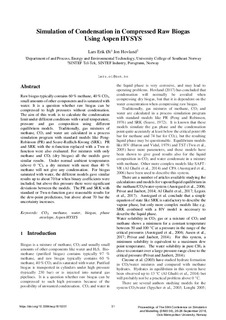| dc.contributor.author | Øi, Lars Erik | |
| dc.contributor.author | Hovland, Jon | |
| dc.date.accessioned | 2019-02-07T13:06:11Z | |
| dc.date.available | 2019-02-07T13:06:11Z | |
| dc.date.created | 2018-12-04T16:47:34Z | |
| dc.date.issued | 2018 | |
| dc.identifier.citation | Linköping Electronic Conference Proceedings. 2018, 31-36. | nb_NO |
| dc.identifier.issn | 1650-3686 | |
| dc.identifier.uri | http://hdl.handle.net/11250/2584372 | |
| dc.description.abstract | Raw biogas typically contains 60 % methane, 40 % CO2, small amounts of other components and is saturated with water. It is a question whether raw biogas can be compressed to high pressures without condensation. The aim of this work is to calculate the condensation limit under different conditions with varied temperature, pressure and gas composition using different equilibrium models. Traditionally, gas mixtures of methane, CO2 and water are calculated in a process simulation program with standard models like Peng-Robinson (PR) and Soave-Redlich-Kwong (SRK). PR and SRK with the a-function replaced with a Twu a-function were also evaluated. For mixtures with only methane and CO2 (dry biogas) all the models gave similar results. Under normal ambient temperatures (above 0 °C), a dry mixture with more than 40 % methane will not give any condensation. For biogas saturated with water, the different models gave similar results up to about 70 bar when binary coefficients were included, but above this pressure there were significant deviations between the models. The PR and SRK with standard or Twu a-function gave reasonable results for the dew-point predictions, but above about 70 bar the uncertainty increases. | nb_NO |
| dc.description.abstract | Simulation of Condensation in Compressed Raw Biogas Using Aspen HYSYS | nb_NO |
| dc.language.iso | eng | nb_NO |
| dc.rights | Navngivelse-Ikkekommersiell 4.0 Internasjonal | * |
| dc.rights.uri | http://creativecommons.org/licenses/by-nc/4.0/deed.no | * |
| dc.title | Simulation of Condensation in Compressed Raw Biogas Using Aspen HYSYS | nb_NO |
| dc.type | Journal article | nb_NO |
| dc.type | Peer reviewed | nb_NO |
| dc.description.version | publishedVersion | nb_NO |
| dc.source.pagenumber | 31-36 | nb_NO |
| dc.source.journal | Linköping Electronic Conference Proceedings | nb_NO |
| dc.identifier.doi | 10.3384/ecp1815331 | |
| dc.identifier.cristin | 1639119 | |
| cristin.unitcode | 222,58,3,0 | |
| cristin.unitname | Institutt for prosess-, energi- og miljøteknologi | |
| cristin.ispublished | true | |
| cristin.fulltext | original | |
| cristin.qualitycode | 1 | |

